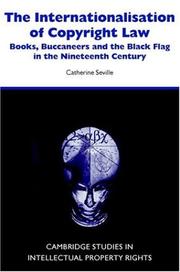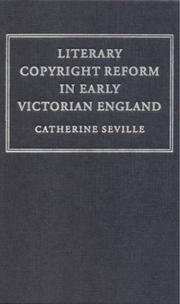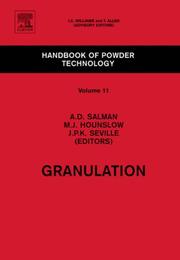| Listing 1 - 8 of 8 |
Sort by
|
Book
ISBN: 074947856X 9780749478568 0749478551 9780749478551 Year: 2016 Publisher: [Place of publication not identified]
Abstract | Keywords | Export | Availability | Bookmark
 Loading...
Loading...Choose an application
- Reference Manager
- EndNote
- RefWorks (Direct export to RefWorks)
Some organizations are able to survive and thrive through times of uncertainty while others stumble and fall at the first sign of trouble. What differentiates resilient organizations from those that are not? Do we need to wait until a crisis strikes to see how resilient an organization is, or can we diagnose resilience in advance of a crisis? Resilient Organizations draws on primary research to reveal the answers to these questions and provide practical ideas and actions to make your own organization more resilient. Organizational resilience is not just about minimizing and managing risk exposure; it is about creating organizations with the agility to adapt to unexpected challenges and the capacity to seize opportunity out of adversity.
Crisis management. --- Crises --- Management of crises --- Management --- Problem solving --- Conflict management --- Crisis management --- Organizational change --- Leadership --- Ability --- Command of troops --- Followership --- Change, Organizational --- Organization development --- Organizational development --- Organizational innovation --- Organization --- Manpower planning --- E-books

ISBN: 1107170958 1281085928 9786611085926 0511348002 1139132385 0511350759 0511348975 0511495277 0511349858 9780511346064 0511346069 9780511349850 9780511348976 0521123038 0521868165 9780521868167 9780521123037 Year: 2006 Publisher: Cambridge ; New York : Cambridge University Press,
Abstract | Keywords | Export | Availability | Bookmark
 Loading...
Loading...Choose an application
- Reference Manager
- EndNote
- RefWorks (Direct export to RefWorks)
Technological developments have shaped copyright law's development, and now the prospect of endless, effortless digital copying poses a significant challenge to modern copyright law. Many complain that copyright protection has burgeoned wildly, far beyond its original boundaries. Some have questioned whether copyright can survive the digital age. From a historical perspective, however, many of these 'new' challenges are simply fresh presentations of familiar dilemmas. This book explores the history of international copyright law, and looks at how this history is relevant today. It focuses on international copyright during the nineteenth century, as it affected Europe, the British colonies (particularly Canada), America, and the UK. As we consider the reform of modern copyright law, nineteenth-century experiences offer highly relevant empirical evidence. Copyright law has proved itself robust and flexible over several centuries. If directed with vision, Seville argues, it can negotiate cyberspace.
Copyright --- Copyright. --- Literary property --- Property, Literary --- Intangible property --- Intellectual property --- Anti-copyright movement --- Authors and publishers --- Book registration, National --- Patent laws and legislation --- History --- Law and legislation --- Law --- General and Others
Multi
ISBN: 9789462984974 9789048535880 9462984972 9048535883 Year: 2019 Publisher: Amsterdam : Amsterdam University Press,
Abstract | Keywords | Export | Availability | Bookmark
 Loading...
Loading...Choose an application
- Reference Manager
- EndNote
- RefWorks (Direct export to RefWorks)
The Game of the Goose is one of the oldest printed board games, dating back 400 years. It has spawned thousands of derivatives: simple race games, played with dice, on themes that mirror much of human activity. Its legacy can be traced in games of education, advertising and polemic, as well as in those of amusement and gambling - and games on new themes are still being developed. This book, by the leading international collector of the genre, is devoted to showing why the Game of the Goose is special and why it can lay claim to being the most influential of any printed game in the cultural history of Europe. Detailed study of the games reveals their historical provenance and - reversing the process - gives unusual insights into the cultures which produced them. They therefore provide rich sources for the cultural historian. This book is beautifully illustrated with more than 90 illustrations, many in color, which are integrated throughout the text.
Recreation. Games. Sports. Corp. expression --- History of civilization --- board games [game sets] --- goose [board game] --- anno 1500-1799 --- anno 1400-1499 --- anno 1800-1899 --- Europe --- Board games --- Board games. --- Goose (Game) --- Goose (Game). --- Gänsespiel. --- History. --- Europa. --- Move games --- Games --- Gameboards --- Cultural history, board games, iconography, art history, history of leisure, printing history.

ISBN: 0521621755 0521174503 1107114837 051100916X 0511173024 0511151977 0511303238 0511495447 1280418788 0511050429 9780511009167 0511035187 9780511035180 9780511173028 9780521621755 9786610418787 6610418780 9780511495441 9780521174503 9781107114838 9781280418785 9780511151972 9780511303234 9780511050428 Year: 1999 Volume: *1 Publisher: Cambridge ; New York : Cambridge University Press,
Abstract | Keywords | Export | Availability | Bookmark
 Loading...
Loading...Choose an application
- Reference Manager
- EndNote
- RefWorks (Direct export to RefWorks)
Talfourd's first Copyright Bill was presented in 1837, and the public and Parliamentary controversy it provoked is reflected in contemporary pamphlets, correspondence, and hundreds of petitions presented to Parliament, as well as in the changing aims of the bill itself. In addition to the expected debate as to the nature of literary property and the economic effects on the publishing trade, discussion of copyright law raised broader questions; the relative values of literature and science, the importance of public education, the dangers of monopolies, and the nature of public interest. In a period of social, political and technological upheaval, these were incendiary matters. Talfourd audaciously demanded not only a considerable extension of copyright term, but also international protection. This book explores and sets in context the making of the Copyright Act 1842, using it to illuminate enduring issues and difficulties in the legal concept of intellectual property.
Copyright --- -Copyright --- Literary property --- Property, Literary --- Intangible property --- Intellectual property --- Anti-copyright movement --- Authors and publishers --- Book registration, National --- Patent laws and legislation --- History --- -Law and legislation --- Great Britain. --- Great Britain --- 19th century --- Law and legislation --- Law --- General and Others
Book
ISBN: 0080983448 0080983375 9780081007471 0081007477 9780080983448 9780080983370 Year: 2016 Publisher: Oxford : Butterworth Heinemann,
Abstract | Keywords | Export | Availability | Bookmark
 Loading...
Loading...Choose an application
- Reference Manager
- EndNote
- RefWorks (Direct export to RefWorks)
Particle Technology and Engineering presents the basic knowledge and fundamental concepts that are needed by engineers dealing with particles and powders. The book provides a comprehensive reference and introduction to the topic, ranging from single particle characterization to bulk powder properties, from particle-particle interaction to particle-fluid interaction, from fundamental mechanics to advanced computational mechanics for particle and powder systems. The content focuses on fundamental concepts, mechanistic analysis and computational approaches. The first six chapters present basic information on properties of single particles and powder systems and their characterisation (covering the fundamental characteristics of bulk solids (powders) and building an understanding of density, surface area, porosity, and flow), as well as particle-fluid interactions, gas-solid and liquid-solid systems, with applications in fluidization and pneumatic conveying. The last four chapters have an emphasis on the mechanics of particle and powder systems, including the mechanical behaviour of powder systems during storage and flow, contact mechanics of particles, discrete element methods for modelling particle systems, and finite element methods for analysing powder systems. This thorough guide is beneficial to undergraduates in chemical and other types of engineering, to chemical and process engineers in industry, and early stage researchers. It also provides a reference to experienced researchers on mathematical and mechanistic analysis of particulate systems, and on advanced computational methods. Provides a simple introduction to core topics in particle technology: characterisation of particles and powders: interaction between particles, gases and liquids; and some useful examples of gas-solid and liquid-solid systems Introduces the principles and applications of two useful computational approaches: discrete element modelling and finite element modelling Enables engineers to build their knowledge and skills and to enhance their mechanistic understanding of particulate systems
Granular materials. --- Particles. --- Size of particles --- Clay --- Colloids --- Sand --- Soils --- Bulk solids --- Materials --- Grammar, Comparative and general Particles --- Particles --- Grammar, Comparative and general --- Function words --- Powders.
Periodical
ISSN: 29518156 Year: 2022 Publisher: Coria del Río, Sevilla : Fundación Pública Andaluza Centro de Estudios Andaluces,
Abstract | Keywords | Export | Availability | Bookmark
 Loading...
Loading...Choose an application
- Reference Manager
- EndNote
- RefWorks (Direct export to RefWorks)
Book
ISBN: 0128113502 0128113499 9780128113509 9780128113493 Year: 2018 Publisher: London, United Kingdom : Academic Press, an imprint of Elsevier,
Abstract | Keywords | Export | Availability | Bookmark
 Loading...
Loading...Choose an application
- Reference Manager
- EndNote
- RefWorks (Direct export to RefWorks)
Coccidia. --- Coccidians --- Coccidida --- Eucoccidiida --- Apicomplexa

ISBN: 1280747129 9786610747122 0080467881 0444518711 9780444518712 9780080467887 Year: 2007 Publisher: Amsterdam ; Oxford : Elsevier,
Abstract | Keywords | Export | Availability | Bookmark
 Loading...
Loading...Choose an application
- Reference Manager
- EndNote
- RefWorks (Direct export to RefWorks)
Granulation provides a complete and comprehensive introduction on the state-of-the-art of granulation and how it can be applied both in an academic context and from an industrial perspective. Coupling science and engineering practices it covers differing length scales from the sub-granule level through behaviour through single granules, to bulk granule behaviour and equipment design. With special focus on a wide range of industrially relevant areas from fertilizer production, through to pharmaceuticals. Experimental data is complemented by mathematical modelling in this emerging field,
Gases --- Particles. --- Separation (Technology) --- Cleaning. --- Analytical chemistry --- Chemistry, Technical --- Technology --- Size of particles --- Clay --- Colloids --- Sand --- Soils --- Gas cleaning --- Dust --- Removal --- Chemical separations --- Separation processes --- Separation science --- Separation technologies --- Separations, Chemical --- Grammar, Comparative and general Particles --- Particles --- Grammar, Comparative and general --- Function words
| Listing 1 - 8 of 8 |
Sort by
|

 Search
Search Feedback
Feedback About UniCat
About UniCat  Help
Help News
News